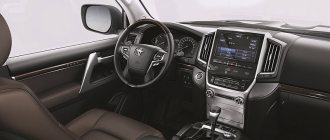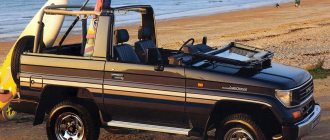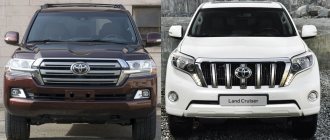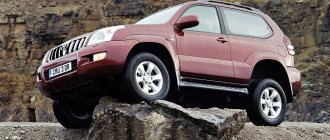Toyota Land Cruiser 70 series is one of the models that seems to always be in fashion. Moreover, the model has gained popularity among various segments of the population around the globe - among American farmers, Russian hunters, and Arabian Bedouins. The Kruzak 70 series has outperformed many Toyota models.
It took longer to come off the production line than its predecessor, the 40 series. More precisely, more than 30 years with minor changes in design and technical parts.
Lively police interest
Probably the most serious off-road vehicle, upon seeing this Land Cruiser Prado, will modestly hide in the bushes. But traffic police inspectors, on the contrary, show a keen interest in him.
Perhaps the presence of a black pipe instead of the front bumper, wheels with a larger diameter than the standard one, and a higher position of the body above the road create a gloomy image. But in the eyes of the law, this Land Cruiser Prado is clean - without any doubt - it is, as they say in sports parlance, homologated for driving on public roads.
Toyota Land Cruiser 70: what are the prospects?
Not long ago we talked about the cessation of sales of Nissan Patrol Y61 series SUVs and Toyota Land Cruiser 70. The well-deserved Patrol will be discontinued this year. And based on the opinion of the Australian representative office of Toyota, we assumed that a similar fate awaited the veteran Land Cruiser 70. However, rumors about the death of the legendary “seventy” turned out to be greatly exaggerated!
The fact is that the Australian market is far from the main market for this model, but only the third in terms of sales. In Australia and Oceania, a little more than 10 thousand 70s are now purchased annually, while in Africa the demand is one and a half times higher. And approximately 60% of the 75 thousand SUVs sold annually end up in the Middle East: oil-producing Kuwait, Bahrain, Oman, Qatar, Saudi Arabia and, of course, the Emirates are the main consumers of the fashionable model in these countries.
It is curious that the model is practically not represented in the rest of Asia: they prefer more modern and affordable Toyota Fortuner SUVs and Hilux pickups, because you can’t approach the “seventy” without at least 45 thousand dollars in your pocket. There is no veteran model in the two largest world markets - China and the USA. Although in Canada an exception has been made for an SUV: the car can be purchased from a single dealer in Saskatchewan, but only as a special vehicle for heavy work in the mining industry and without permission to drive on public roads. Therefore, North American sales are vanishingly small: only about a hundred cars a year. In Japan, the Land Cruiser 70 stopped selling 12 years ago, although in 2014, in honor of the model’s thirtieth anniversary, the Japanese government issued a sales permit for exactly one year. And the only European country where the Land Cruiser 70 can be bought from official representatives is tiny Gibraltar.
Five-door SUV Toyota Land Cruiser 76
Long-wheelbase three-door SUV Toyota Land Cruiser 78
Four-door pickup Toyota Land Cruiser 79
Two-door pickup Toyota Land Cruiser 79
Three-door SUV Toyota Land Cruiser 71 with soft top
0 / 0
The reason for such low prevalence is the model’s inconsistency with modern safety and environmental standards. Toyota Land Cruiser 70 is produced at two Toyota Auto Body plants in Japan, and CKD assembly is organized in Bangladesh (at the Aftab plant), Kenya (Associated Vehicle Assemblers - AVA) and Portugal (Toyota Caetano). However, assembly in Asia and Africa is focused on local dealers; the Portuguese make cars exclusively for South Africa. And cars with 1GR-FE gasoline engines (V6 4.0, 231 hp), 1HZ naturally aspirated diesel engines (4.2 l, 6 cylinders in a row, 131 hp) or 1VD-FTV turbodiesels (V8) come off Japanese production lines. 4.5, 207 hp), which for the most part comply only with Euro-4 standards.
0 / 0
As for safety, crash tests according to the Australian ANCAP program brought the “seventy” only 22.88 points out of 37 possible and three stars out of five. Moreover, in 2010, the Australians tested a truck with two frontal airbags, which had already appeared a year earlier, but without ABS - the Land Cruiser 70 received this system only two years later. Interestingly, most of the points were awarded for exemplary side impact resistance, while the frontal crash test brought only 6.88 points out of a maximum of sixteen.
ANCAP crash test: 64 km/h, 40% overlap, deformable barrier
This November, Euro 5 environmental standards and more stringent safety requirements come into force in Australia: for example, the presence of a stabilization system will become mandatory. Toyota is ready to make sacrifices: it has already been announced that the “Seventy” will have ESP and three additional airbags - curtains and a knee airbag for the driver. But all this is only true for the single-row cab pickup: the thirteen-seat Troop Carrier with three doors, the six-seat pickup and the traditional five-door station wagon all look set to leave the Australian market after all.
How to make up for the loss of such a large market? It is possible that the “seventy” will be officially sold in Russia for the first time! Until now, these cars were imported to us only by “gray” dealers, and some of them even provided their own guarantee. Fumitaka Kawashima, vice president of the Russian representative office of Toyota, spoke about the likelihood of “legalization” at the beginning of the year. Will a “Japanese UAZ” costing approximately three million rubles be in demand in our market? Famous for its indestructibility, but at the same time poor quality of paint, and potentially falling into the luxury category with a corresponding increase in transport tax? You definitely shouldn’t count on rush demand, but after the departure of the Land Rover Defender SUV (in recent years it found 300-350 buyers annually), the “seventy” may well occupy its niche.
Toyota's Russian office has not yet confirmed to us the release of the Land Cruiser 70 model to the Russian market. But they didn’t refute it either.
On the roads...
The redesigned suspension radically changed the car's behavior on asphalt. She's soft. Because of this, the car sways on the road, like a schooner in slight excitement (fisherman Sonya would probably appreciate it). But directional stability is quite acceptable. If you don't make any sudden movements with the steering wheel, the Land Cruiser stays well on the road, even at a speed of just over 100 km/h. But when turning, you need to exercise maximum caution. Body roll is strong. In addition, if the car hits a bump while turning, the body begins to sway. True, in fairness, it must be said that everything is limited only to unpleasant sensations.
The engine has enough power to not feel inferior in any driving situation. It’s not for nothing that the 1KZ engine is considered one of the best for SUVs. The engine power is enough to quickly accelerate the car, despite the fact that the engine has to spin large wheels. Dynamic capabilities allow you not only to keep up with the general flow, but also to “run away” from it both at the start and while driving. The flexible automatic transmission shifts gears both up and down very quickly and smoothly. And the huge torque of the diesel engine calmly pulls the car in top gear from 40 km/h. At the same time, the car can confidently accelerate without switching to a lower gear.
Land Cruiser 70 interior and safety
The front panel remained unchanged until 2007. It has been modernized, but it still feels like the car is not a simple one. Excellent ergonomics, comfortable fit - this distinguishes Toyota from domestic UAZs. But the car's safety is still not very good.
The capacity of the troop carrier version, for example, according to Toyota, is 13 people. The front row alone can accommodate three people - a driver and two passengers. But crash tests carried out in 2010 gave very poor results - only 3 stars out of a possible 5.
The dummy placed in the driver's seat injured its legs. Passengers (also mannequins) in the front seat received strong blows to the chest area. The steering wheel and pedals moved inward, and the driver's door had to be cut out altogether.
...and without them
The suspension works very well off-road. The energy intensity is high, so, for example, you can rush across the steppe at high speed without fear of puncturing the suspension. But on long “waves” a buildup occurs, as a result of which the car gets into resonance and a strong bump appears, forcing you to sharply reduce speed.
The Land Cruiser's geometric cross-country ability is excellent. Even a large base is not a hindrance - a competent elevator has reduced the ramp angle to such an extent that you can no longer be afraid of terrain bends. And the ground clearance, thanks to the large wheels, has become significant - much more than the standard 220 mm familiar to most basic SUVs. Very large compression and rebound strokes practically compensate for the lack of inter-wheel locking. Even on strong slopes, the Land Cruiser Prado rests on the ground with all four wheels.
It never came to the point of fully mobilizing all the capabilities of the car - there was no suitable terrain at our disposal. And this Prado is capable of a lot. The main thing is not to forget one very simple rule: if you “plant” such a machine in the mud, then it will be very difficult to pull it out of there without performing a large amount of excavation work.
Walking Wide
On the move, our Land Cruiser Prado is stately and imperturbable. He, like a large ocean liner, carries himself with dignity above a boring existence. And we were clear before the traffic police. Even when we got onto a straight and flat country road, our speed barely reached the permitted 80 km/h. The thrust reserve of the three-liter turbodiesel is, of course, huge, and the non-standard exhaust system makes very peppy sounds.
However, asphalt “excitement” provokes the body to very distinct rocking. So you don’t want to make any sudden movements at high speeds. However, the owner of the car said that he accelerated it to quite decent speed for an SUV.
Well, our forced march from the asphalt is completed. Ahead is a dirt road of average lousiness. I get behind the wheel, but there is some ambiguity in this seemingly simple action. The seat seems to be comfortable, and the nice Nardi sports steering wheel caresses my palms with its leather rim, but I feel uncomfortable. Perhaps this is due to the unusually high landing. Well, okay, I'll figure it out as I go.
The automatic transmission lever is in the drive position and gas. The car comes to life very spiritedly, and I really like this pace. I go through several turns in one breath, and the first troubles with my arrangement in the driver’s seat are completely forgotten. The Italian steering wheel perfectly transmits my commanding actions to the front wheels, and the seat perfectly keeps me from unnecessary vibrations. But the body vibrations become excessive, and I slow down the pace I had gained. Now it would be nice to go to rough terrain. And here she is. Lumps, holes – the lifted suspension of this Prado doesn’t care at all. It seems that it is simply impossible to completely choose her moves. I didn’t think about engaging all-wheel drive or downshifting – there was no need for either of them. However, later the colleague still climbed into some kind of swamp, where he had to connect the front axle.
But what began to worry me again was the same excessive body swing. With it, of course, you can move over rough terrain, but with a good degree of accuracy, calculating all possible options in advance. And this will require good skills.











